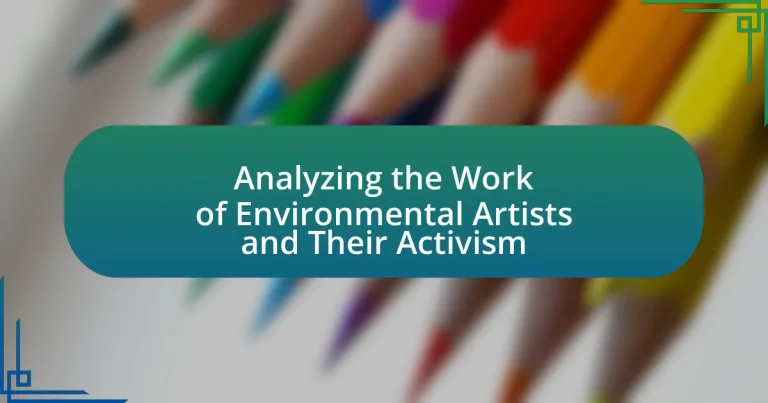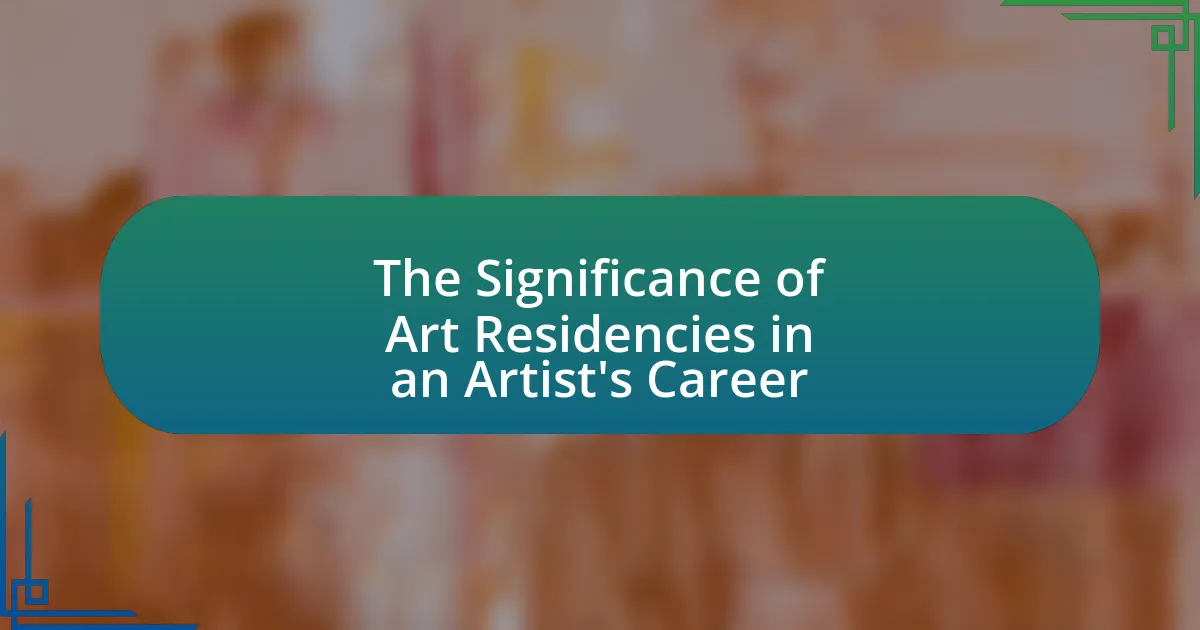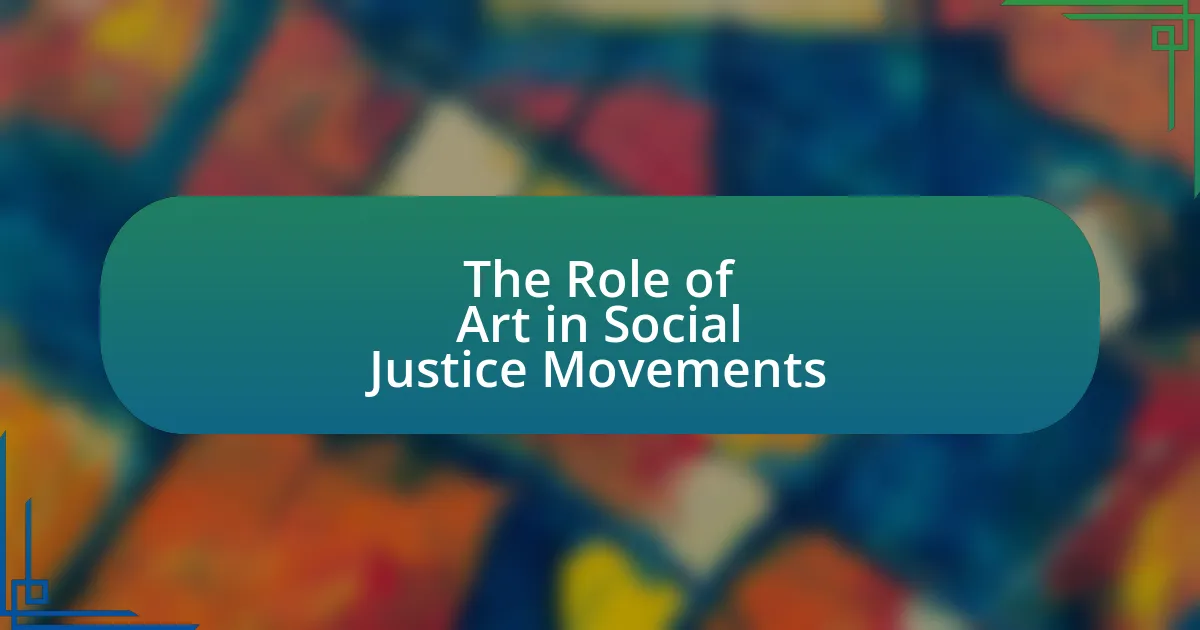Environmental art and activism encompass artistic practices that address ecological issues and promote environmental awareness through various mediums. The article analyzes how environmental artists contribute to activism by raising awareness about climate change, pollution, and habitat destruction, often using natural materials and immersive installations to engage the public. Key themes explored include sustainability, the critique of consumerism, and the role of art in influencing public perception and policy-making. Additionally, the article highlights practical steps individuals can take to support environmental artists and participate in community art projects, emphasizing the importance of art as a tool for fostering dialogue and inspiring action on environmental issues.
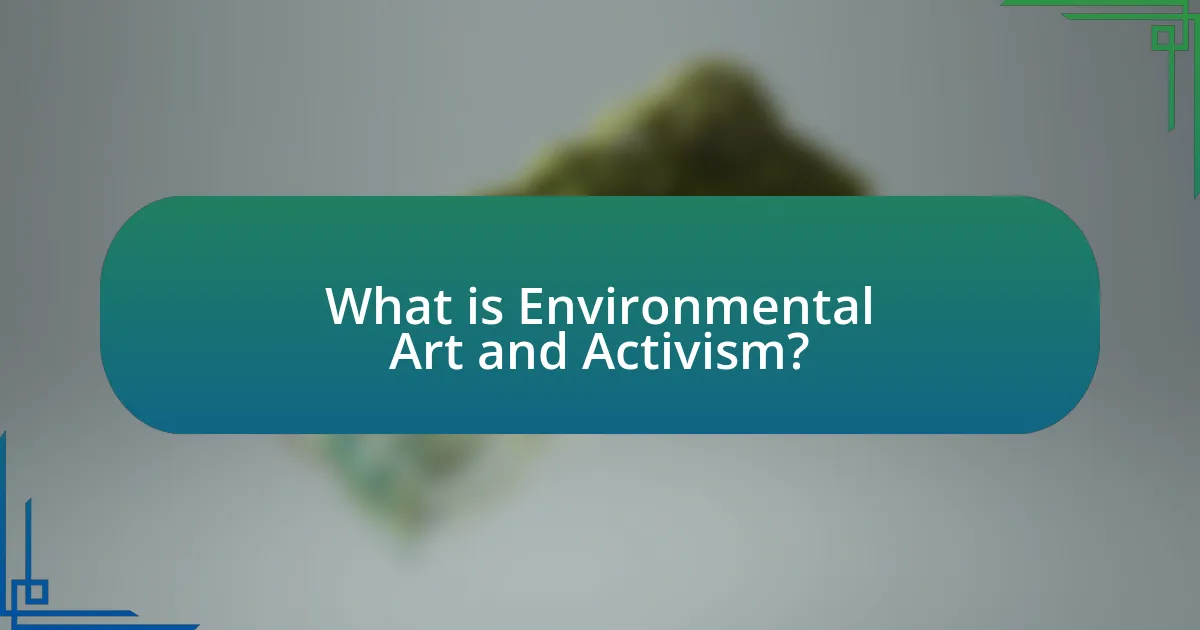
What is Environmental Art and Activism?
Environmental art and activism refer to artistic practices that address ecological issues and promote environmental awareness. This form of art often utilizes natural materials and settings to create works that highlight the relationship between humans and the environment, aiming to inspire change and provoke thought regarding environmental conservation. For instance, artists like Andy Goldsworthy create site-specific installations using natural elements, which emphasize the beauty and fragility of nature. Additionally, environmental activism through art can be seen in movements such as the Land Art movement of the 1960s and 1970s, where artists sought to engage with and comment on environmental degradation. This intersection of art and activism serves as a powerful tool for raising awareness and encouraging sustainable practices.
How do environmental artists contribute to activism?
Environmental artists contribute to activism by using their art to raise awareness about environmental issues and inspire action. They create works that highlight the impact of climate change, pollution, and habitat destruction, often engaging the public in dialogue about these critical topics. For instance, projects like Christo and Jeanne-Claude’s “The Gates” in Central Park not only beautified the space but also drew attention to the importance of public art in environmental discourse. Additionally, artists like Olafur Eliasson use installations to create immersive experiences that encourage viewers to reflect on their relationship with nature, thereby fostering a sense of urgency around environmental conservation. Through these creative expressions, environmental artists effectively mobilize communities and influence policy discussions, making their contributions to activism both impactful and essential.
What mediums do environmental artists use to express their message?
Environmental artists use a variety of mediums to express their message, including natural materials, installation art, photography, video, and performance art. These mediums allow artists to engage with the environment directly, often utilizing elements like soil, water, and plants to create works that highlight ecological issues. For instance, artists like Andy Goldsworthy use natural materials to create site-specific installations that emphasize the beauty and fragility of nature. Additionally, photography and video are employed to document environmental changes and raise awareness about climate change, as seen in the works of artists like Edward Burtynsky, who captures industrial landscapes to provoke thought on human impact. Performance art also serves as a medium, where artists enact scenarios that reflect environmental concerns, fostering a deeper emotional connection with the audience.
How does the work of environmental artists raise awareness about ecological issues?
Environmental artists raise awareness about ecological issues by creating impactful works that engage the public and provoke thought regarding environmental degradation. Their art often incorporates natural materials and themes, highlighting the beauty of nature while simultaneously addressing its fragility. For instance, projects like Christo and Jeanne-Claude’s “The Gates” in Central Park not only beautified the landscape but also sparked discussions about urban space and environmental conservation. Additionally, artists like Olafur Eliasson use installations to visualize climate change, making abstract concepts tangible and relatable. This approach effectively communicates the urgency of ecological issues, encouraging viewers to reflect on their relationship with the environment and inspiring action towards sustainability.
Why is environmental art important in today’s society?
Environmental art is important in today’s society because it raises awareness about ecological issues and promotes sustainability. This form of art engages the public in conversations about environmental challenges, such as climate change and habitat destruction, by using visual and experiential methods to convey messages. For instance, projects like Christo and Jeanne-Claude’s “The Gates” in Central Park not only beautified the landscape but also sparked discussions about land use and environmental stewardship. Additionally, studies show that art can influence public perception and behavior regarding environmental conservation, making it a powerful tool for activism.
What role does environmental art play in climate change discussions?
Environmental art plays a crucial role in climate change discussions by raising awareness and fostering emotional connections to environmental issues. This form of art often visually represents the impacts of climate change, making abstract concepts more tangible and relatable for the public. For instance, projects like Olafur Eliasson’s “Ice Watch,” which displayed large blocks of ice in urban settings, directly confronted viewers with the realities of melting glaciers, prompting reflection and dialogue about climate action. Such artistic interventions not only engage audiences but also inspire activism and policy change by highlighting the urgency of environmental challenges.
How does environmental art influence public perception of environmental issues?
Environmental art significantly influences public perception of environmental issues by engaging audiences emotionally and intellectually. This form of art often highlights ecological concerns through visual representation, prompting viewers to reflect on their relationship with nature. For instance, works like Christo and Jeanne-Claude’s “The Gates” in Central Park not only beautified the space but also sparked discussions about urban nature and environmental stewardship. Research indicates that art can enhance awareness and motivate action; a study published in the journal “Environmental Communication” found that art installations can increase public engagement with environmental topics by up to 30%. Thus, environmental art serves as a powerful tool for raising awareness and fostering a deeper understanding of ecological challenges.
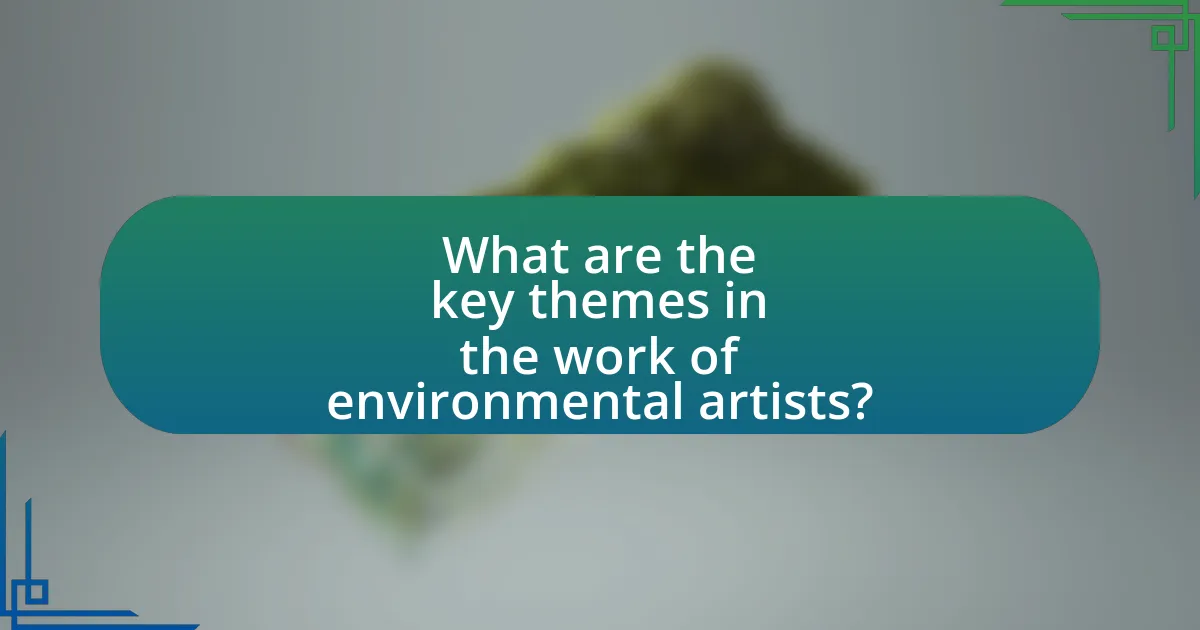
What are the key themes in the work of environmental artists?
Key themes in the work of environmental artists include ecological awareness, sustainability, and the critique of consumerism. These artists often focus on the relationship between humans and nature, highlighting environmental issues such as climate change, habitat destruction, and pollution. For instance, artists like Andy Goldsworthy utilize natural materials to create site-specific works that emphasize the beauty and fragility of ecosystems. Additionally, many environmental artists engage in activism, using their art to inspire action and raise awareness about pressing environmental challenges, as seen in the works of Olafur Eliasson, who addresses climate change through immersive installations.
How do environmental artists address sustainability in their work?
Environmental artists address sustainability by integrating ecological principles into their creative processes and materials. They often utilize recycled, natural, or biodegradable materials to minimize environmental impact, exemplified by artists like Andy Goldsworthy, who uses local stones and organic materials to create site-specific installations. Additionally, their work frequently raises awareness about environmental issues, encouraging public engagement and dialogue on sustainability. For instance, the “Plastic Ocean” installation by artist Angela Haseltine Pozzi highlights the impact of plastic pollution on marine life, effectively combining art with activism to promote conservation efforts.
What specific sustainability practices are highlighted in environmental art?
Environmental art highlights specific sustainability practices such as the use of recycled materials, promoting biodiversity, and raising awareness about climate change. Artists often incorporate found objects and repurposed materials in their work to minimize waste and encourage a circular economy. Additionally, many environmental artists create installations that support local ecosystems, such as planting native species or restoring habitats, thereby fostering biodiversity. Furthermore, these artists engage the public through their work, educating audiences about environmental issues and inspiring action towards sustainability, which is evidenced by projects like Christo and Jeanne-Claude’s “The Gates,” which drew attention to Central Park’s landscape and environmental concerns.
How do these practices inspire action among viewers?
Environmental artists inspire action among viewers by creating immersive experiences that evoke emotional responses and raise awareness about ecological issues. These practices often utilize visual storytelling, interactive installations, and public engagement to connect audiences with the environment, prompting them to reflect on their own impact. For instance, projects like Olafur Eliasson’s “The Weather Project” in the Tate Modern not only captivated viewers but also encouraged discussions about climate change and sustainability. Research indicates that art can significantly influence public perception and motivate behavioral change, as evidenced by studies showing that art-based interventions can lead to increased environmental activism and community involvement.
What social and political issues are often explored through environmental art?
Environmental art often explores social and political issues such as climate change, environmental justice, and the impact of industrialization on natural landscapes. Artists use their work to raise awareness about the consequences of pollution and habitat destruction, advocating for sustainable practices and policies. For instance, the work of artists like Olafur Eliasson highlights the urgency of climate action, while projects addressing water rights emphasize the disparities faced by marginalized communities. These artistic expressions serve as a catalyst for dialogue and activism, reflecting the interconnectedness of environmental health and social equity.
How do environmental artists engage with local communities?
Environmental artists engage with local communities by creating site-specific artworks that reflect local environmental issues and cultural narratives. These artists often collaborate with community members to gather insights and incorporate local materials, fostering a sense of ownership and connection to the artwork. For example, projects like “The Floating Piers” by Christo and Jeanne-Claude involved extensive community involvement in planning and execution, demonstrating how art can serve as a platform for dialogue about environmental concerns. This engagement not only raises awareness but also encourages community action towards sustainability and environmental stewardship.
What impact does environmental art have on policy-making?
Environmental art significantly influences policy-making by raising public awareness and fostering dialogue about environmental issues. This form of art often highlights ecological concerns, prompting policymakers to consider these issues in their agendas. For instance, projects like Christo and Jeanne-Claude’s “The Gates” in Central Park not only attracted millions of visitors but also sparked discussions on urban space and environmental conservation, leading to increased support for green initiatives in urban planning. Additionally, studies have shown that art can effectively communicate complex scientific data, making it more accessible to the general public and policymakers alike, thereby facilitating informed decision-making.
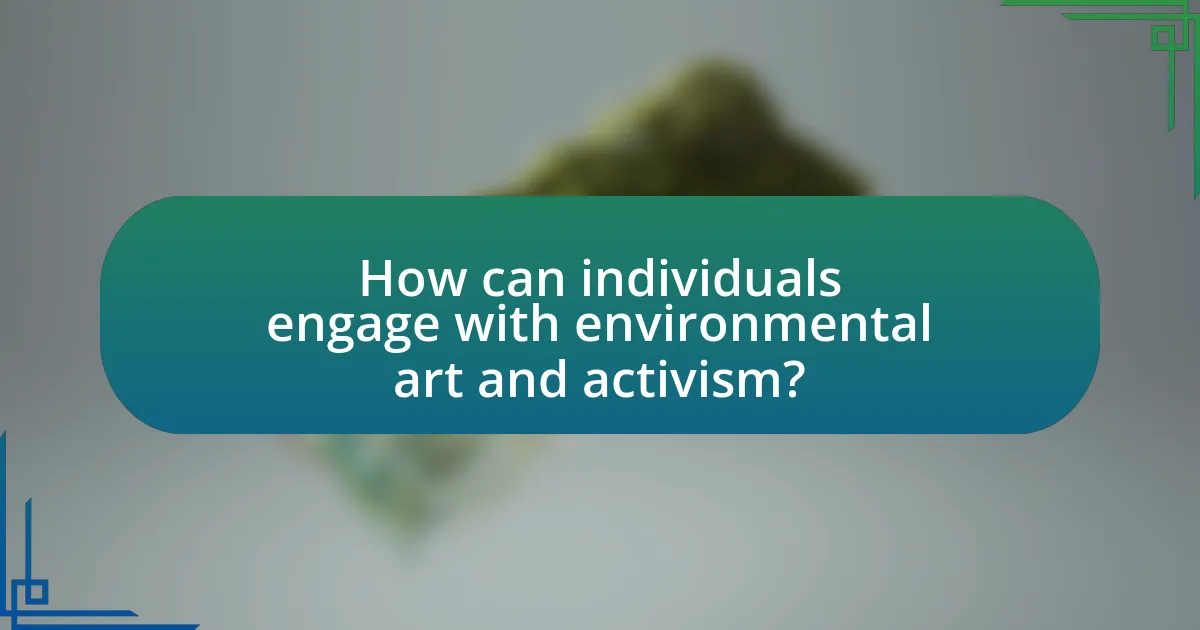
How can individuals engage with environmental art and activism?
Individuals can engage with environmental art and activism by participating in community art projects, attending exhibitions, and supporting artists who focus on environmental themes. Community art projects often involve local residents in creating works that address environmental issues, fostering a sense of ownership and awareness. Attending exhibitions allows individuals to experience and reflect on the messages conveyed through environmental art, which can inspire action. Supporting artists, whether through purchasing their work or promoting their initiatives, helps amplify the impact of environmental art and raises awareness about pressing ecological concerns.
What are some ways to support environmental artists?
Supporting environmental artists can be achieved through various methods, including purchasing their artwork, promoting their projects on social media, and attending their exhibitions. Purchasing artwork directly contributes to the artists’ financial stability and allows them to continue their environmental advocacy. Promoting their projects on social media increases visibility and can attract a wider audience, which is essential for raising awareness about environmental issues. Attending exhibitions not only shows support but also provides opportunities for networking and collaboration, further enhancing the impact of their work. These actions collectively foster a supportive community that values and amplifies the voices of environmental artists.
How can individuals participate in environmental art projects?
Individuals can participate in environmental art projects by engaging in community initiatives, volunteering for local art installations, or creating their own environmentally themed artworks. Community initiatives often involve collaborative efforts to raise awareness about environmental issues through art, such as organizing clean-up events that incorporate artistic expression. Volunteering for local art installations allows individuals to contribute their time and skills to projects that highlight ecological concerns, fostering a sense of community and shared purpose. Additionally, creating personal artworks that reflect environmental themes can inspire others and promote dialogue about sustainability. Participation in these projects not only enhances individual creativity but also strengthens community ties and raises awareness about environmental issues.
What resources are available for learning about environmental art?
Books, online courses, and documentaries are key resources for learning about environmental art. Notable books include “Environmental Art” by Andrew Brown, which provides insights into the movement and its key figures, and “Art and Ecology Now” by Andrew Brown, which explores contemporary practices. Online platforms like Coursera and edX offer courses on environmental art and sustainability, featuring lectures from experts in the field. Documentaries such as “Waste Land,” which follows artist Vik Muniz as he collaborates with garbage pickers in Brazil, illustrate the intersection of art and environmental activism. These resources collectively enhance understanding of environmental art and its impact on ecological awareness.
What practical steps can individuals take to promote environmental activism through art?
Individuals can promote environmental activism through art by creating and sharing artworks that raise awareness about environmental issues. This can include organizing community art projects that focus on themes like climate change, pollution, or biodiversity loss, which engage local audiences and encourage dialogue. Additionally, individuals can utilize social media platforms to showcase their art, reaching a broader audience and inspiring others to take action. Collaborating with environmental organizations to host exhibitions or workshops can further amplify the message, as seen in initiatives like the “Art for the Earth” project, which successfully combined art and activism to educate the public on sustainability.
How can art be used as a tool for community engagement in environmental issues?
Art can be used as a tool for community engagement in environmental issues by fostering awareness and inspiring action through visual storytelling and interactive experiences. For instance, public art installations, such as murals or sculptures, can highlight local environmental challenges, making them more relatable and urgent to community members. Research shows that projects like the “Trash Isles” campaign, which aimed to raise awareness about ocean plastic pollution through art, successfully engaged communities by transforming complex issues into accessible visual narratives. This approach not only educates but also encourages collective participation in environmental advocacy, as seen in initiatives like the “Earth Day Network,” which utilizes art to mobilize communities around sustainability efforts.
What are effective strategies for organizing environmental art events?
Effective strategies for organizing environmental art events include collaboration with local artists, community engagement, and sustainable practices. Collaborating with local artists ensures that the event reflects the community’s environmental concerns and cultural context, fostering a sense of ownership and relevance. Engaging the community through workshops or discussions prior to the event can generate interest and participation, as seen in initiatives like the “Art in the Park” series, which successfully involved local residents in the creative process. Implementing sustainable practices, such as using eco-friendly materials and minimizing waste, not only aligns with the environmental theme but also sets a standard for attendees, as demonstrated by events like the “EcoArt Festival,” which reported a 30% reduction in waste through careful planning.
